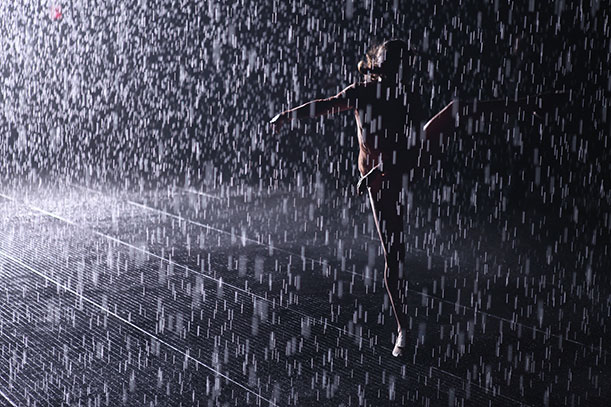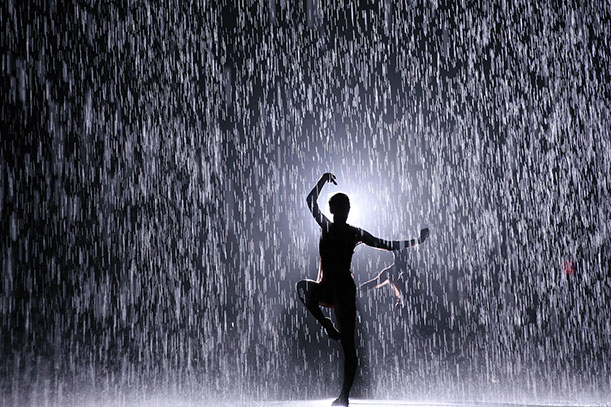This Incredible Art Installation Makes It Rain, Everywhere But On You
“Rain Room,” on display at MoMA, is an indoor downpour that detects the presence of people and adjusts to keep them dry
Rain Room is on display at MoMA, in conjunction with EXPO 1: New York, through July 28, 2013. Image by Charles Roussel.
What if we could control the weather? The thought has more than crossed the minds of Stuart Wood, Florian Ortkrass and Hannes Koch, the three founders of the London-based art studio Random International. In their latest installation, Rain Room, now at the Museum of Modern Art in New York City, the artists have created an indoor downpour that detects passers-through and actually adjusts, to keep them dry.

Visitors test the responsiveness of the downpour, and in the process, Rain Room becomes a stage of sorts. Image by Charles Roussel.
Visitors are lining up to walk—or even dance—through the temporary exhibition, staged in a lot next to MoMA, on West 54th Street between Fifth and Sixth Avenues. As waves of people, ten at a time, are invited in, the 1,000-square-foot rain shower becomes a stage where improvised performances happen, as guests test how well the rainfall responds to their movements. Random International installed 3D cameras to track people throughout the space and thereby control which water spouts in the ceiling are on and which are off at any given time. Nearly 220 gallons of water fall every minute; the water gets filtered and cycles through again and again. For effect, a spotlight, positioned at one side of the room, casts light through the staccato dashes of pressurized water and produces rainbows. The creators say that the downpour is a static noise from within, blocking out extraneous sounds and making it a meditative place.
Rain Room had its first successful run at Barbican Centre in London from October 2012 to March 2013, and it has now become a popular attraction stateside at MoMA’s EXPO 1: New York, a festival-like presentation of ecologically-focused projects. Art critic Ken Johnson, in a review in the New York Times, expressed some skepticism, rightfully so, of the installation’s fit with this theme. Visitors, he writes, “may wonder what it contributes to deep thinking about ecological issues.” He even goes on to say, “‘Rain Room,’ for all its entertaining ingenuity, seems little more than a gimmicky diversion.” But, in its defense, MoMA argues that what the work does is encourage people “to explore the roles that science, technology, and human ingenuity can play in stabilizing our environment.”

Nearly 220 gallons of water fall every minute; the water gets filtered and cycles through again and again.. Image by Charles Roussel.
Creator Stuart Wood has called Rain Room a “social experiment”—and it is immersive experiences like this one, in completely new environments, that Random International specializes in. The group’s 2008 project Audience had visitors walk through a field of small mirrors; the mirrors would single out a person and turn towards that individual in one fluid and “inquisitive” motion, as the artists put it. In 2011, the outfit created Swarm Study / III. The lighting installation, which hangs in the Victoria and Albert Museum in London, is four cubes composed of illuminated brass rods that respond to activity on the staircase beneath them. On MoMA’s Inside/Out blog, Random International explained its driving force. It is quite simple, really. “We’re intrigued by how people and objects behave and respond to one another,” said the group.
Rain Room is on display at MoMA through July 28, 2013.
/https://tf-cmsv2-smithsonianmag-media.s3.amazonaws.com/accounts/headshot/megan.png)

/https://tf-cmsv2-smithsonianmag-media.s3.amazonaws.com/accounts/headshot/megan.png)